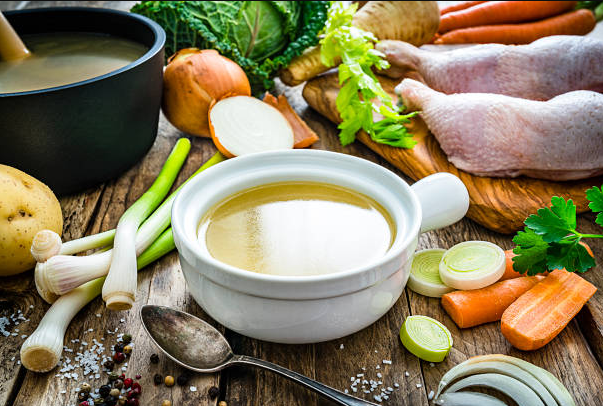Introduction
Chicken bouillon is a staple ingredient in kitchens worldwide. Whether you’re making soup, rice, or a savory sauce, chicken bouillon adds depth and rich flavor to your dishes. But what exactly is chicken bouillon? How is it used, and why has it become so popular in both home and commercial cooking?
In this article, we’ll break down everything you need to know about chicken bouillon — from its types and benefits to DIY recipes and healthy alternatives. Whether you’re a home cook, a health-conscious eater, or just curious about what’s in your pantry, this guide will give you a full picture of this versatile ingredient.
What Is Chicken Bouillon?
Chicken bouillon is a concentrated flavoring made from chicken stock or broth that’s been dehydrated or reduced into a powder, cube, or paste. It usually contains salt, chicken extract, spices, and preservatives. Bouillon is designed to mimic the taste of slow-simmered chicken broth and is commonly used to flavor soups, stews, rice, pasta, and vegetables.
Bouillon comes in three primary forms:
Chicken Bouillon Cubes – Hard, compact cubes that dissolve in water.
Chicken Bouillon Powder – Easier to mix and often preferred for even seasoning.
Chicken Bouillon Paste or Liquid – Rich and concentrated; typically refrigerated.
Ingredients in Chicken Bouillon
While recipes vary by brand, most chicken bouillon contains the following ingredients:
Dehydrated chicken stock or extract
Salt
Monosodium glutamate (MSG) (optional in some brands)
Onion and garlic powder
Spices and herbs (turmeric, parsley, thyme)
Palm oil or other fats
Preservatives
Tip: Always check the ingredient list, especially if you’re on a low-sodium diet or avoiding MSG.
Popular Brands of Chicken Bouillon
Here are a few widely used chicken bouillon brands:
Knorr Chicken Bouillon
Maggi Chicken Bouillon
Better Than Bouillon Chicken Base
Herb-Ox Chicken Bouillon (MSG-free)
Wyler’s Chicken Bouillon
These brands are commonly available in stores and online and vary in taste, texture, and dietary options.
How to Use Chicken Bouillon
- Soups and Stews
Add bouillon to water to create an instant broth base. Ideal for chicken noodle soup, lentil soup, or stews. - Rice and Pasta
Use bouillon in place of plain water when cooking rice, couscous, or pasta for extra flavor. - Sauces and Gravies
Mix with warm water to make a flavorful base for gravies or creamy sauces. - Marinades
Enhance chicken or vegetable marinades with bouillon for a deeper umami taste. - Seasoning
Sprinkle powdered bouillon directly into stir-fries, roasted vegetables, or popcorn for an extra savory kick.
Health Benefits of Chicken Bouillon
While it’s mostly used for flavor, chicken bouillon can have some nutritional benefits when consumed in moderation:
Hydration: Helps replenish fluids and electrolytes, especially in soups
Low Calories: Provides flavor without adding significant calories.
Comfort Food: Warm bouillon-based dishes can be soothing when you’re ill or recovering.
However, be cautious of high sodium levels in commercial bouillon products, which can lead to increased blood pressure if overconsumed.
Homemade Chicken Bouillon Recipe
Making your own bouillon ensures better quality and control over ingredients.
Ingredients:
1 whole chicken carcass (or bones)
1 onion, chopped
2 carrots, chopped
2 celery stalks, chopped
2 garlic cloves
1 tsp turmeric
1 tsp salt (adjust to taste)
Herbs: thyme, parsley, bay leaf
8 cups water
Instructions:
Add all ingredients to a large pot and bring to a boil
Reduce heat and simmer for 4–6 hours.
Strain the broth and discard solids.
Simmer the liquid further to reduce it to a concentrated paste.
Pour into ice cube trays or jars and freeze
Now you have a homemade chicken bouillon base — no preservatives, no MSG, and full flavor!
Chicken Bouillon vs Chicken Broth: What’s the Difference?
| Feature | Chicken Bouillon | Chicken Broth |
| Form | Cube, powder, or paste | Liquid |
| Shelf Life | Long (dry or refrigerated) | Short (unless canned) |
| Flavor | More concentrated | Milder, lighter |
| Convenience | Easy to store and use | Requires storage space |
| Ingredients | Can contain additives | Typically more natural |
Both have their uses, but bouillon is the go-to for convenience and space-saving.
Healthy Alternatives to Chicken Bouillon
If you’re looking to avoid additives or reduce sodium, try these:
Homemade chicken stock or broth
Low-sodium bouillon cubes
Vegetable bouillon or mushroom-based bouillon
Miso paste (for a similar umami taste)
Nutritional yeast (for vegan-friendly flavoring)
Common Questions About Chicken Bouillon
Q: Is chicken bouillon gluten-free?
Some are, but many contain wheat-based ingredients. Look for certified gluten-free labels.
Q: Is chicken bouillon healthy?
It’s fine in moderation. Watch out for high sodium and additives like MSG if you’re sensitive.
Q: Can I use bouillon in place of chicken broth?
Yes! Just mix the bouillon cube or powder with water according to instructions.
Q: Does bouillon expire?
Dry bouillon can last for years unopened. Once opened, keep it in a cool, dry place or refrigerate if it’s paste-based.
Final Thoughts
Chicken bouillon is a powerhouse ingredient that brings bold flavor to countless dishes. Whether you use it for soups, sauces, or rice, it’s a pantry essential that delivers convenience and taste. While store-bought options are widely available, making your own at home gives you a healthier and cleaner alternative.
By understanding what goes into your bouillon and how to use it creatively, you’ll not only improve your cooking but also make smarter, healthier choices.


